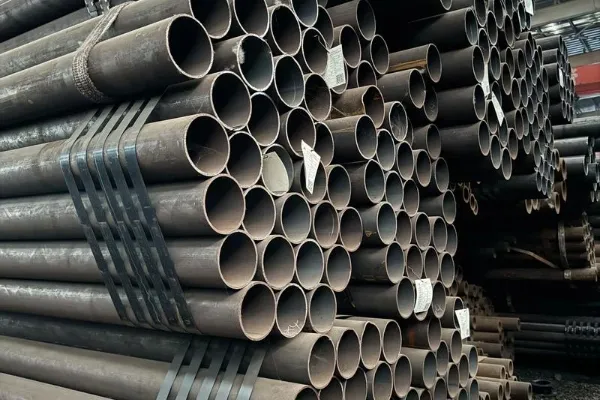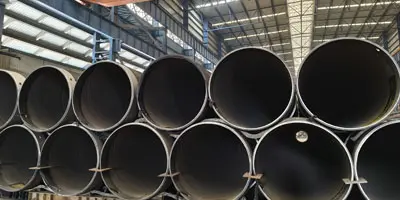With such a wide variety of seamless steel pipes on the market, it can be quite dazzling, making it difficult to choose the right one. So, what issues should be considered when selecting seamless steel pipes? Let me answer this question for you.

What are the common outer diameters, wall thicknesses, and materials of seamless steel pipes?
Common outer diameters of seamless steel pipes include Ф21.3, Ф48, Ф57, and Ф68, while wall thickness varies from 0.5mm to tens of millimeters depending on the application. In specific fields, such as petrochemicals and machinery manufacturing, wall thickness is typically required to be above 2mm; in the construction industry, wall thickness is relatively thinner, usually above 1mm.
Materials for seamless steel pipes used in engineering include 10#, 20#, 35#, 45#, 16Mn, J55, K55, N80, L80, X42, and X52. Different materials and manufacturing processes are selected based on different projects and working environments. Wall thickness has a significant impact on the performance and price of seamless steel pipes. Excessive wall thickness increases production costs and also reduces the material's strength and corrosion resistance. Therefore, when selecting seamless steel pipes, it is necessary to choose the appropriate specifications and wall thickness based on the actual application and requirements.
How to choose seamless steel pipe correctly?
1. Define the application scenario and requirements.
When selecting seamless steel pipes, the first step is to define the project requirements, including the operating environment, working pressure and temperature, and application type: For high-temperature and high-pressure environments, choose carbon steel or alloy steel pipes with high temperature and pressure resistance; for corrosive media, stainless steel or pipes with special anti-corrosion treatment are required; for high-pressure boilers and petrochemical pipelines, select appropriate wall thickness and material according to the pressure rating; when transporting oil, gas, and water, pay attention to corrosion resistance and inner wall smoothness, while for mechanical structures, focus on mechanical properties such as tensile strength, impact resistance, and hardness.
2. Master Specifications and Match Requirements Accurately
The specifications of seamless carbon steel pipes include outer diameter, wall thickness, and length. These parameters directly determine the pipe's load-bearing capacity and performance.
Outer Diameter and Wall Thickness: The outer diameter of seamless steel pipes ranges from 6mm to 630mm, and the wall thickness varies from 2.0mm to 30mm. The selection of outer diameter and wall thickness needs to be determined comprehensively based on factors such as working pressure, flow requirements, and installation space. The calculation formulas are: Inner Diameter = Outer Diameter - 2 × Wall Thickness, Outer Diameter = Inner Diameter + 2 × Wall Thickness, Wall Thickness = (Outer Diameter - Inner Diameter)/2.
Length Specifications: The standard length is 6 meters, but can be customized according to customer needs. For large-diameter pipes, the length can reach 12 meters or more. Length requirements should be clearly specified during procurement to avoid waste caused by on-site cutting.
Theoretical Weight Calculation: The weight of seamless steel pipes can be calculated using the formula [(Outer Diameter - Wall Thickness) × Wall Thickness] × 0.02466 = kg/meter. For example, a seamless steel pipe of No. 20 with an outer diameter of 89mm and a wall thickness of 4.5mm weighs approximately (89-4.5)×4.5×0.02466=9.38kg per meter.
3.Know Applicable Standards
Compliance with national standards ensures quality and safety:
|
Standard
|
Application
|
Materials
|
Notes
|
|
GB/T8162-2018
|
Structural steel pipes
|
10#, 20#, Q345
|
General mechanical structures
|
|
GB/T8163-2018
|
Fluid transportation
|
10#, 20#, Q345
|
Design temp <350℃, pressure <10 MPa
|
|
GB3087-2022
|
Low/medium-pressure boilers
|
Carbon steel
|
Superheated/boiling tubes
|
|
GB5310-2023
|
High-pressure boilers
|
Alloy & carbon steel
|
High-temp, high-pressure water-tube boilers
|
|
GB6479-2013
|
Chemical fertilizer equipment
|
High-pressure carbon steel
|
Temp -40~400℃, pressure 10~30 MPa
|
|
GB9948-2013
|
Petroleum cracking
|
Carbon steel
|
Furnace tubes, heat exchangers
|
Application Scenarios and Selection Recommendations
Oil and Gas Transportation: Prioritize seamless steel pipes meeting API 5L standard, such as X80 grade pipes, with working pressures up to 12MPa.
Chemical Equipment: Select high-pressure seamless steel pipes for fertilizer equipment meeting GB6479 standard, with working temperatures ranging from -40 to 400℃ and working pressures from 10 to 30MPa.
Boiler Equipment: Use GB3087 standard for low and medium pressure boilers, and GB5310 standard for high-pressure boilers. Supercritical units require alloy steel such as 12Cr1MoVG, with working temperatures up to 570℃.
Mechanical Manufacturing: Hydraulic systems should use 45# steel cold-drawn precision tubing, offering high dimensional accuracy and a surface roughness Ra≤0.8μm.
3.Manufacturing Process Selection
The manufacturing process directly affects the performance and application suitability of seamless carbon steel tubes. Hot-rolled seamless carbon steel tubes are commonly used for large-diameter, thick-walled applications, especially suitable for high-temperature and high-pressure environments. Choose the wall thickness and manufacturing method. High-pressure pipelines require thick-walled seamless tubes, while thin-walled cold-drawn tubes can be used for lightweight structures. Hot-rolled seamless tubes are suitable for general structural applications, while cold-rolled or cold-drawn tubes can provide strict tolerance requirements for precision equipment.
Verify dimensional and specification standards. Pipe dimensions are expressed in nominal diameter and wall thickness (wall thickness grade), while tube dimensions are expressed in outer diameter and wall thickness. Ensure dimensions meet design requirements and comply with relevant standards (e.g.,
ASTM, ASME).
Consider mechanical performance requirements. For applications subjected to dynamic loads or vibrations, the high tensile strength and elasticity of seamless steel tubes are particularly significant.
4. Choosing the Right Supplier
Selecting the right supplier and procurement strategy is crucial to ensuring the quality and delivery of seamless steel pipes.
Supplier Qualifications: Prioritize manufacturers with ISO9001 certification and special equipment manufacturing qualifications, and require them to provide material certificates, non-destructive testing reports, and third-party testing reports.
On-site Inspection: For large-scale purchases, it is recommended to conduct on-site inspections of production equipment, inventory, and quality systems, focusing on whether they have a CNAS laboratory and a complete quality control process.
Reasonable Price Comparison: Comprehensively evaluate quality, delivery time, and service, and be wary of quality risks associated with significantly lower prices.
Delivery Time and After-sales Service: Clearly define delivery cycles and liabilities for breach of contract, and choose suppliers who can provide timely after-sales and technical support.
Conclusion: Making the Right Choice
Selecting seamless steel pipes is a technical decision that requires careful evaluation of material properties, engineering requirements, and supplier capabilities. By considering the factors outlined above—standards compliance, production methods, corrosion resistance, connection types, and cost control—you can ensure the long-term performance and safety of your piping system.
For businesses looking to source high-quality seamless steel pipes, partnering with a reputable manufacturer with a proven track record in quality assurance and customer support is essential. Whether for oil and gas, chemical processing, or infrastructure projects, making an informed decision will lead to cost savings, improved durability, and enhanced operational efficiency.
Would you like recommendations for the best suppliers or additional guidance on selecting seamless steel pipes for your specific industry? Let us know how we can assist you!
BAOWI Steel maintains strict quality control from production to delivery, ensuring every steel pipe meets global standards for strength, durability, and precision.






 English
English Español
Español بالعربية
بالعربية











 Phone :
Phone :  Whatsapp :
Whatsapp :  Email :
Email : 


